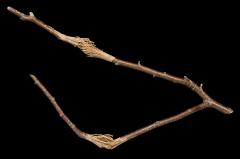
1915.33.1 Donated by Rev C. V. Goddard, said to be broken in the twisting motion of water divining. Wiltshire.
In the Pitt Rivers Museum there are a two water divining rods, donated by the anthropologist Edward Burnett Tylor in 1893. Each is cut at the junction of two twigs forming a V shape. They are stated to have been made by a professional water-finder in about 1880 near Wells in Somerset.
In an article on Malay Divining Rods published in 1902, Tylor records what he states was his only experience "of the methods of the English water-finder." He states that it was some 20 years ago at Somerleaze, the home of Professor E.A. Freeman the Historian. He says that they invited a well-known and successful dowser in the Mendip district to come and demonstrate how he used his forked hazel divining rod. He was, Tylor states "a straightforward man, thoroughly believing in his craft and undeniably a successful well-sinker."
In his trials the diviner emphasised the difference between surface springs and "main springs" which would give a permanent supply of water. Tylor says that it was not a serious trial and that it would not have been difficult to find suitable places near Wells in any case. They then asked the diviner if he could find treasure. Tylor's watch, a large old-fashioned gold repeater was hidden in the house under rugs, and he states that the rod sipped not far from where the watch lay. The diviner said that when he had found it, he had felt by the rod that he was over "a good main-spring."
In a letter from Freeman's wife Eleanor to Anna Tylor following this trial, which confirms it took place in January 1883, she comments on the dowsing trial, which evidently had found a convert in the Freeman household. She states "I am sure Mr Tylor would have been amused if he had heard our gardener talking about his hazel twig this evening - & showing us how perfectly it dipped over the main spring of his watch. With him it certainly bent over but was unmaleable in my hands. William certainly thinks he has quite the power of divining now."
This suggests not only that the dowser demonstrated his craft, but that he made a rod for the gardener, and most likely also for the Tylors to try out dowsing, which they donated to the Pitt Rivers Museum ten years later. Whether Tylor tried his hand at dowsing he does not say, but given his interest in investigating spiritualist séances, it seems most likely that he was keen to get to the root of what was happening.
In 1902, in comparing the Malay divining rods to the English and the range of things they can be used to find, he asks what they have in common. He states "Nothing but that the diviner wants to find something. The divining instrument has no physical relation with the water more than with stolen goods, or murderers, or the time of day; it only follows the seeker's state of mind and body."
Tylor suggests that it is only that the diviner personifies the rods and imagines that they are giving him information. He notes that Malay diviners may believe the rods to be possessed by a demon and used to drive out other demons, and that European divining rods used to be taken to church wrapped in baby's clothes to get them surreptitiously christened.
Tylor, Edward B. 1902 40. Malay Divining Rods, Man, Vol.2, pp.49-50